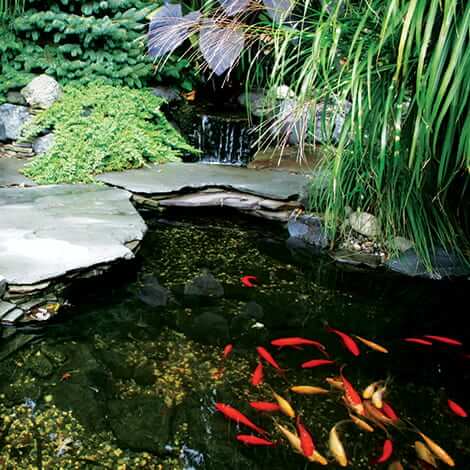A well-balanced pond ecosystem is a complex mixture of fresh water, microbes, and an array of minerals that create a perfect environment for plants and fish to thrive. Creating and maintaining this ecosystem is easier when you have a solid understanding of the basics. Let’s dive into the nitrogen cycle, why it is vital for all aquatic life, and how to promote it in your pond.
Pond Nitrogen Cycle 101
The nitrogen cycle in a koi pond is the foundation for biological filtration processes that keep the water clean and balanced. Without a functioning nitrogen cycle, high levels of ammonia and nitrites can harm fish and other aquatic life.
Nitrogen enters a pond from the atmosphere through rainfall, wind, and runoff. Organic debris like leaves, twigs, and fish waste also contain nitrogen that gets released into the water as ammonia. All of this nitrogen decays over time with the help of nitrifying bacteria called Nitrosomonas and Nitrobacter.
Nitrosomonas consume ammonia and excrete nitrites. Nitrobacters then oxidize and convert these nitrites into harmless nitrates. The nitrates are then reduced by water changes or consumed by aquatic plants and algae.
Boost Nitrifying Bacteria Levels
To increase the number of beneficial Nitrosomonas and Nitobacter, seed your filter media with Pure+ Filter Start Gel or PL Gel. Add Nature's Defense to the water every other week and boost dissolved oxygen levels with an Aeration Kit to propagate good bacteria in your pond.
Some beneficial bacteria can survive the cold winter in your filtration media and gravel, but it’s a good idea to give them a boost in spring. Seasonal Defense is formulated for use in cooler temperatures, making it perfect for spring start-up applications.
New Pond, New Bacteria
Nature takes time to establish an abundant population of beneficial nitrifying bacteria. When a pond is first started, it is best to wait four to six weeks before adding fish. This will allow the pond to fully cycle and settle before adding new residents. While low nitrate levels are safe for fish, it is best to establish a robust population of beneficial bacteria that can handle organic fish waste before introducing them.
Prepare your pond water for new fish by monitoring ammonia and nitrite levels using a master test kit. Once the test indicates safe levels, the pond is ready for fish. Start by adding only a few small fish to see how they adapt before adding more.
Pro Tip: As fish grow, they will produce more waste, so limit your pond to around one koi or two goldfish per 200 gallons of water.
Tips for Supporting Nitrifying Bacteria in Your Pond
A thriving beneficial bacteria population is essential for promoting a robust nitrogen cycle in your pond. If you still have questions about when and how to add bacteria, contact us online or by phone at 866-POND-HELP. Our friendly water garden experts are here to guide you!
Read more about natural bacterial treatments for water gardens in these related articles:
Why Pond Water Changes Are Important
Using Beneficial Bacteria for Clear Water
Benefits of the DefensePAC
When to Use Seasonal Defense
How to Keep Pond Filters From Clogging
Last Updated: July 10, 2024
